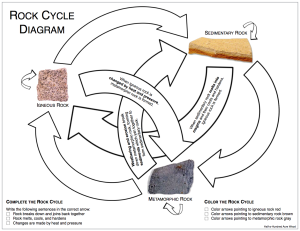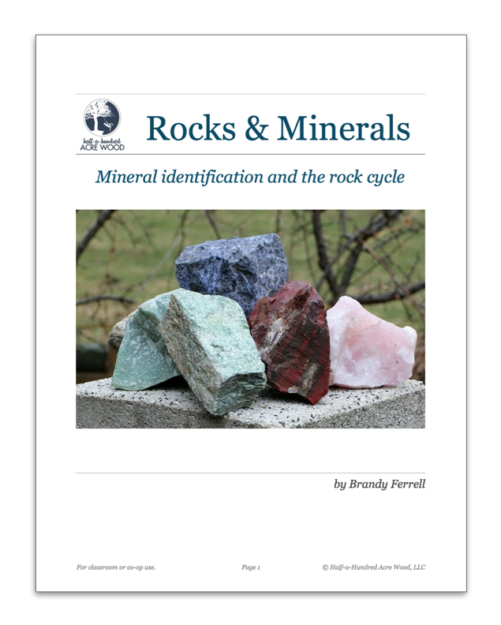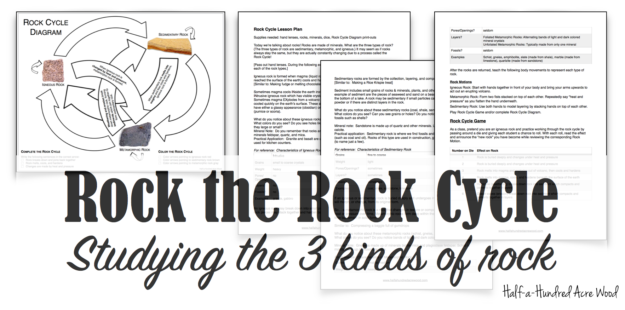Now that we’ve had an introduction to minerals, we’re diving into a short study of rocks with our rock cycle lesson plans!
For this lesson, students will need a hand lens, some rocks, some minerals, a die, and the Rock Cycle Diagram print-out (included in our Introduction to Rocks and Minerals Lesson Packet). This lesson uses the relatively inexpensive Toysmith Rock Science Kit and Toysmith Mineral Science Kit.

If you’d also like to “cook up” the rock cycle, you’ll also need some melting chocolates or ingredients/supplies to make fudge, ingredients/supplies to make Rice Krispie treats, and a baggie full of gumdrops.
The following notes are taken from our Introduction to Rocks and Minerals Lesson Plan and Activity Packet. Our lesson and activity packet includes:
- A detailed script
- Characteristics of each type of rock in a simple tabular format
- Practice with determining the minerals that may be present in a rock
- Practical applications for each type of rock
- Kinesthetic activities for remembering details of the rock cycle
- The Rock Cycle Diagram printable
- Two additional lessons on mineral identification!
Download a sample of our Rocks and Minerals Lesson Packet.

Introduction to Rocks and Minerals Lesson Packet
Format: PDF Download (Mac & PC Compatible), 38 pages.
Price: $19.99 for a classroom or co-op license


Format: PDF Download (Mac & PC Compatible), 38 pages.
Price: $7.00 for a family


Three Types of Rock
Igneous rock is formed when magma (liquid rock inside the earth) or lava (magma that has reached the surface of the earth) cools and hardens. Igneous rock may be intrusive or extrusive, which affects the size of the crystals in the rock. (A detailed explanation is in our lesson packet.)
[Similar to: Making fudge or melting chocolate and letting it cool/harden.]
Sedimentary rocks are formed by the collection, layering, and compaction of sediment.
[Similar to: Making a Rice Krispie treat]
Sediment includes small grains of rocks & minerals, plants, and other organic matter. Examples of sediment are the pieces of seaweed and sand on a beach or the muddy debris at the bottom of a lake. A rock may be sedimentary if small particles can be rubbed off as grains/powder or if there are distinct layers in the rock.
If an igneous or sedimentary rock is buried deeply and undergoes intense heat and pressure, it will morph, or change, from its original form.
A metamorphic rock is a rock that changes in texture or composition as a result of extreme heat or pressure over time. Metamorphic rocks form deep within the earth over a long period of time but remain in solid form.
[Similar to: Compressing a baggie full of gumdrops.]
Rock Motions & Rock Cycle Game
Igneous Rock: Start with hands together in front of your body and bring your arms upwards to act out an erupting volcano.
Metamorphic Rock: Form two fists stacked on top of each other. Repeatedly say “heat and pressure” as you flatten the hand underneath.
Sedimentary Rock: Use both hands to model layering by stacking hands on top of each other.
As a class, pretend you are an igneous rock and practice working through the rock cycle by passing around a die and giving each student a chance to roll. With each roll, read the effect from the chart included in our lesson packet and announce the “new rock” you have become while reviewing the corresponding Rock Motion. Finish up by completing the Rock Cycle Diagram and do a great-big-ole rock monster dance! You’ve just rocked the rock cycle!
This lesson uses the rocks and minerals from the Toysmith Rock Science Kit and Toysmith Mineral Science Kit.

Purchase the Introduction to Rocks and Minerals Lesson Packet – Classroom or Co-op License
This 38-page resource provides complete lessons for teaching mineral and rock identification to children through the use of mineral identification stations, hands-on activities, and simple charts. Note: The Toysmith Rock Science Kit and Toysmith Mineral Science Kit will be needed for these lessons.
Format: PDF Download (Mac & PC Compatible), 38 pages.
License: For use within a classroom or co-op of up to 60 children.
Suggested grades: K to 6 (although resources may be used for older students as well)
Price: $19.99 for a classroom or co-op license



Purchase the Introduction to Rocks and Minerals Lesson Packet – Family License
This 38-page resource provides complete lessons for teaching mineral and rock identification to children through the use of mineral identification stations, hands-on activities, and simple charts. Note: The Toysmith Rock Science Kit and Toysmith Mineral Science Kit will be needed for these lessons.
Format: PDF Download (Mac & PC Compatible), 38 pages.
License: For use within a single family.
Suggested grades: K to 6 (although resources may be used for older students as well)
Price: $7.00 for a family



